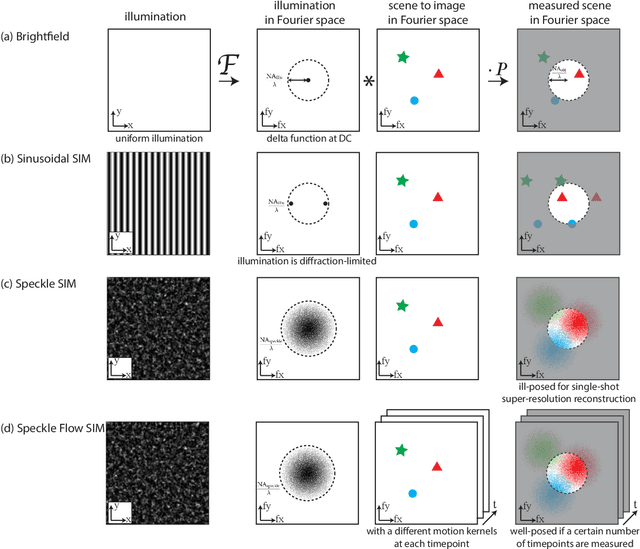Li-Hao Yeh
Dynamic Structured Illumination Microscopy with a Neural Space-time Model
Jun 03, 2022



Abstract:Structured illumination microscopy (SIM) reconstructs a super-resolved image from multiple raw images; hence, acquisition speed is limited, making it unsuitable for dynamic scenes. We propose a new method, Speckle Flow SIM, that models sample motion during the data capture in order to reconstruct dynamic scenes with super-resolution. Speckle Flow SIM uses fixed speckle illumination and relies on sample motion to capture a sequence of raw images. Then, the spatio-temporal relationship of the dynamic scene is modeled using a neural space-time model with coordinate-based multi-layer perceptrons (MLPs), and the motion dynamics and the super-resolved scene are jointly recovered. We validated Speckle Flow SIM in simulation and built a simple, inexpensive experimental setup with off-the-shelf components. We demonstrated that Speckle Flow SIM can reconstruct a dynamic scene with deformable motion and 1.88x the diffraction-limited resolution in experiment.
Structured illumination microscopy with unknown patterns and a statistical prior
Jan 12, 2017
Abstract:Structured illumination microscopy (SIM) improves resolution by down-modulating high-frequency information of an object to fit within the passband of the optical system. Generally, the reconstruction process requires prior knowledge of the illumination patterns, which implies a well-calibrated and aberration-free system. Here, we propose a new \textit{algorithmic self-calibration} strategy for SIM that does not need to know the exact patterns {\it a priori}, but only their covariance. The algorithm, termed PE-SIMS, includes a Pattern-Estimation (PE) step requiring the uniformity of the sum of the illumination patterns and a SIM reconstruction procedure using a Statistical prior (SIMS). Additionally, we perform a pixel reassignment process (SIMS-PR) to enhance the reconstruction quality. We achieve 2$\times$ better resolution than a conventional widefield microscope, while remaining insensitive to aberration-induced pattern distortion and robust against parameter tuning.
Experimental robustness of Fourier Ptychography phase retrieval algorithms
Dec 18, 2015



Abstract:Fourier ptychography is a new computational microscopy technique that provides gigapixel-scale intensity and phase images with both wide field-of-view and high resolution. By capturing a stack of low-resolution images under different illumination angles, a nonlinear inverse algorithm can be used to computationally reconstruct the high-resolution complex field. Here, we compare and classify multiple proposed inverse algorithms in terms of experimental robustness. We find that the main sources of error are noise, aberrations and mis-calibration (i.e. model mis-match). Using simulations and experiments, we demonstrate that the choice of cost function plays a critical role, with amplitude-based cost functions performing better than intensity-based ones. The reason for this is that Fourier ptychography datasets consist of images from both brightfield and darkfield illumination, representing a large range of measured intensities. Both noise (e.g. Poisson noise) and model mis-match errors are shown to scale with intensity. Hence, algorithms that use an appropriate cost function will be more tolerant to both noise and model mis-match. Given these insights, we propose a global Newton's method algorithm which is robust and computationally efficient. Finally, we discuss the impact of procedures for algorithmic correction of aberrations and mis-calibration.
 Add to Chrome
Add to Chrome Add to Firefox
Add to Firefox Add to Edge
Add to Edge